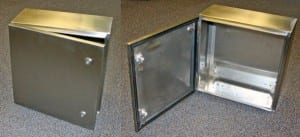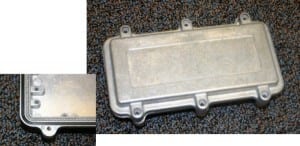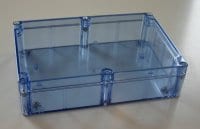As governments encourage companies to get ‘greener’, more company product teams are designing electronics for use in photovoltaic solar power systems, wind turbines and other equipment used in alternative energy. Even traditional energy systems, which use electronics to control, monitor and consolidate the flow of electricity, are in demand as the global industrial expansion continues. With the emergence of the smart grid, the need for electronics will only accelerate. Purchasing agents, therefore, should understand the special needs of selecting enclosures for the unique needs of the energy industry.
The proper selection of an enclosure can make a significant difference in the success or failure of a product, both from a design standpoint and from a marketing perspective. In the push to develop products, purchasers often overlook the enclosure until the end of the design cycle when they can’t give their choice of enclosure the attention it deserves. To assist in this crucial process, this article offers five issues to consider when selecting enclosures for energy applications.
Location, location, location. As in real estate, location is a crucial factor in enclosure selection. Where the product is going to be installed and used determines the types of materials required and the level of protection needed. For example, wind turbines have devices that control the pitch of the blades. Because the device is being used outdoors, specific NEMA requirements need to be met. Typically, NEMA 4 or 4x enclosures are the best for an outdoor application, although in some situations, a NEMA 12 enclosure will do. NEMA 4 and 4x protect against powerful sprays of water such as might be received during a major rain storm. A NEMA 12 enclosure is appropriate in more protected locations where only dripping water might be encountered. In this application, experts recommend a stainless-steel NEMA 4x box that can withstand the elements and also provide the strength and durability needed to hold the heavy equipment.

Bud’s SNB Series stainless-steel boxes are the best choice for outdoor enclosure applications.
On the flip side, a console used to house environmental controls in a big box store might installed in a typical 19-inch cabinet rack. As it is located indoors, in an office or warehouse setting, no specific protection is required.
Don’t stall the installation. The capabilities of the box also are very important. When mounting a printed circuit board, an enclosure with mounting bosses can be a huge help in maintaining the integrity of the box and speeding installation. If a board is not the primary component, or if a variety of components are being utilized, then having a mounting panel that can readily be installed in the base of the enclosure can be the perfect approach to rapid assembly. Many control boxes are mounted on other equipment or on walls to avoid the damage that might occur if they are left on the floor. Boxes that include brackets or have brackets as an integral part of the enclosure assist in this attachment process.
Beyond installation concerns, other capabilities to consider include the availability of enclosure accessories and, of course, the available space within the enclosure. Given today’s compressed time-to-market goals, delivery delays can be a real problem. Purchasing agents should understand that selecting a standard enclosure will save precious time over a custom design. If the exact size enclosure is not readily available, then consider a slightly larger enclosure that is in stock. Also, going with a standard-size and style enclosure will open up the choice of vendors, A little homework will identify suppliers who have equivalent products for dramatically less cost, including some who can ship orders on the same day they are received.
Form follows function. Specific needs of the application can also drive the choice of enclosure. For example, if the project requires UL approval, then it is often easier to obtain this approval if the box is already UL certified.
Other ratings to be considered include the NEMA ratings mentioned above and EMI/RFI. An application that involves collecting excess power from solar panels may need protection both from the elements and from radio waves. In such applications the ideal solution is a die-cast aluminum enclosure that has a double layer of gaskets: a metallic inner gasket for RFI protection and a silicone outer gasket to seal out moisture.

Bud’s ANS Series enclosure provides double protection: NEMA and EMI/RFI.
In addition to environmental protection, designers should consider the need for future expansion. Dimensions are important in an enclosure selection, and often engineers try to save space. While a small footprint is desirable in the short term, it may cause significant expense in the long term if the enclosure is too small to accommodate additional components.
Another issue is the need for output tracking. If there are meters to be read, consider NEMA plastic enclosures that come with clear lids. The see-through lids eliminate the need to modify the enclosure with cutouts and also avoid having to acquire NEMA-rated readouts.

The BT Series from Bud is the first totally transparent NEMA-rated enclosure.
Weight may be an issue for solar power systems that are roof-mounted, in which case plastic or aluminum enclosures make the most sense. For a wind turbine, the concern may be security, and a locking steel enclosure is the answer.
Style matters. A non-technical aspect of enclosure selection is the visual appearance of the enclosure. Particularly if an enclosure will be used in an office or home environment, the look and feel of the enclosure is an important part of its design. The purchaser should select the enclosure colors and materials that will help promote the product and ease its acceptance. No homeowner will want an industrial style box controlling his or her solar energy system. A NEMA plastic box with smooth lines would be an obvious choice, as it provides protection against the environment. Plastic can be molded in various colors, providing an easy match with any décor. Even if the enclosure is destined for the factory floor, a visual identity is important to companies trying to differentiate their products in the marketplace.
Custom fit. A final consideration of enclosure selection is the ease of customization. Unwanted costs may creep into a project when the purchaser fails to consider enclosure modifications.
Some enclosures come with knockouts for cable access or other accommodations, but most enclosures cannot be used unless they are modified per the specific I/O requirements of the internal equipment. A typical application may require modifications that vary from adding holes, cutouts, or slots to providing silk-screening, decals, or special finishes that reflect instructional and marketing needs.
Because the vendor has the equipment and experience to easily modify enclosures, it is faster and less expensive to have enclosure supplier make the changes.
Choosing an enclosure for an energy application should not be a hasty, last-minute decision. The choice of the wrong box or cabinet can ruin the chances for customer acceptance of the product and create needless delays in the product introduction. By focusing on the few basic steps outlined above, the enclosure choice can be the final step in insuring a successful product launch.




